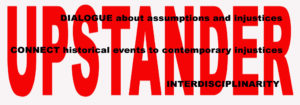RESEARCH TO IMPROVE SOCIAL JUSTICE ART EDUCATION CURRICULA
How can educators foster in their students’ a critical consciousness of the systems of inequality so that they actually embody upstander behaviors that challenge the injustices they confront on a daily basis? How can we teach towards everyday brave upstander actions? In the social justice curricula that we developed as encounters with the different series of Linda Stein’s art, our purpose is to foster critical consciousness and upstander action to challenge injustice.
The Curricular team (C-team) invites those interested in teaching social justice through our encounters with art to use the curricula and interactive website with your students.
To help the C-team to improve these encounters and to provide evidence of the effectiveness of our website, we invite you to participate in our research. We ask you to respond to 5 open-ended questions prior to using the website, and 4 open-ended questions after exploring the website for possible use in your teaching. Your responses will be confidential and will not include identifiers. Your participation is entirely voluntary and you can opt out at any time.
- Respond to the pre-questionnaire at http://h2f2encounters.cyberhouse.emitto.net/pre-encounters-questionnaire/
- Facilitate one or more encounters with the guides and resources provided at http://h2f2encounters.cyberhouse.emitto.net/encounters/
- Then respond to the post-questionnaire at http://h2f2encounters.cyberhouse.emitto.net/post-encounters-questionnaire/
Thank you for helping the H2F2 curriculum research team develop social justice education through art!
OVERVIEW OF RESEARCH FINDINGS
In a 2017-18 project, funded by the National Art Education Foundation, a team of six researchers analyzed the usefulness of curricula intended to teach social justice through art. The overarching purpose, supported by a social justice art education (SJAE) curricular encounters website is to promote the critical consciousness necessary to challenge injustice.
Four themes emerged in the analysis of the data:
● One pathway for the SJAE curricular encounters to serve as a catalyst for intended upstander behavior is to present works of art in ways that engage dialogical interaction. The data suggested that SJAE curricular encounters that support exploration of artistic practices with specific contexts about the artists’ processes could stimulate interactive dialogues that connect historical events with contemporary social injustice.
● Secondly, the data suggested SJAE curriculum encounters presented opportunities to initiate conversation concerning challenging topics such as bullying and feminism. While many participants raised concerns about the backlash that might occur when introducing issues surrounding social justice, most considered the SJAE curriculum encounters as a platform to cultivate a community of inquiry that questions assumptions and respects different perspectives.
● The third finding concerning whether SJAE curricular encounters can serve as an effective catalyst for intended upstander behavior, is that social justice is reinforced by various teachers, in various subjects, in various ways.
● Further, the data suggested that interdisciplinary approaches may be beneficial toward teaching social justice.
Below is a data visualization of key findings.

The research continues with a publication in process as well as the development of the SJAE website. Your responses to the survey and additional feedback is most welcome.
The C-team: Karen Keifer-Boyd (kk-b@psu.edu), Cheri Ehrlich, Ann Holt, Yen-Ju Lin, Wanda B. Knight, Adetty Pérez de Miles, and Linda Hoeptner Poling in collaboration with Linda Stein.
